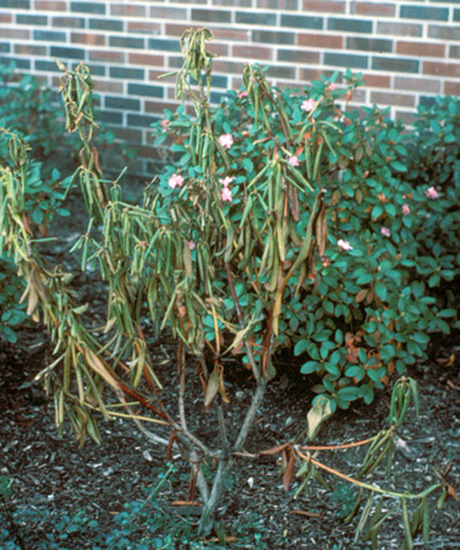Issue 7, June 4, 2010
Rhododendrons Limited by More than Phytophthora Root Rot
I have always said that the two most limiting factors to rhododendron production in Illinois are alkaline/clay soil conditions and Phytophthora root rot. That thought did not originate with me but I certainly agree with it based on what I have seen in the clinic over the years (30+). If you have a rhododendron that is suffering but does not have Phytophthora root rot, consider the possibilities of Botryosphaeria canker or Armillaria root rot. Also consider noninfectious possibilities such as poor drainage, wet conditions, deep or shallow planting, and other abiotic factors. Diseases are not always the problem.
Some Phytophthora species can also affect rhododendron foliage. In issue 1 of 2010 we discussed Ramorum blight (SOD), which can infect rhododendron foliage. There are also non-exotic foliar Phytophthora pathogens of rhododendron. This article, however, is focused on Phytophthora root rot and its look-a-likes.
Phytophthora root rot can be caused by many species, the most common being Phytophthora cinnamomi. Most plant clinics cannot identify this pathogen to the exact species. When it is critical to know the species, the sample or isolate can be outsourced to specialty labs.
Phytophthora infected roots will be reddish brown rather than healthy white. Roots die and the reduced root mass cannot absorb enough water or nutrients to support top growth. Often the top of the plant quickly turns dull green and foliage rolls as seen in the image.

You will not be able to save infected plants, but proper identification of the problem can go a long way in preventing spread to other rhododendrons. Since poorly drained soils allow disease development even in some resistant rhododendrons, obviously proper soil preparation and good drainage are keys to disease control. Composted hardwood bark media has been used to suppress growth of Phytophthora cinnamomi. Chemical drenches are available for commercial growers to help prevent disease spread in the planting. For more on Phytophthora of rhododendrons, consult RPD No. 664, Phytophthora root rot or wilt of rhododendron and azaleas in the Midwest.
As you might imagine, any root or stem related problem could produce similar top symptoms of dull green, rolled foliage. Flooding, drought, mechanical or chemical injury to roots could cause similar symptoms.
Botryosphaeria dieback is another disease look-a-like. Many of you have seen Botryosphaeria dieback in trees. The fungal pathogen is known to invade stressed or injured wood, causing cankers at the base of branches. On rhododendron, the foliage on cankered branches turns off-color and rolls, just as with Phytophthora root rot. Botryosphaeria is characterized by black pin-head sized fruiting bodies in the cankers on older wood. Infected branches may be removed to help plant recovery. Botryosphaeria typically follows drought stress whereas Phytophthora follows wet weather.
Armillaria root rot of rhododendron has been reported to cause similar looking top symptoms to what has been discussed above. Armillaria may form mushrooms that help in pathogen ID. It may form shoestring-like structures as well. Rotted roots may be covered in white mycelium that can be diagnostic in the lab. For details on Armillaria root rot, consult this University of Illinois disease report.
Hopefully you will now look at wilted rhododendrons a bit more judiciously. Phytophthora is not always the cause of declining rhododendrons.--Nancy Pataky